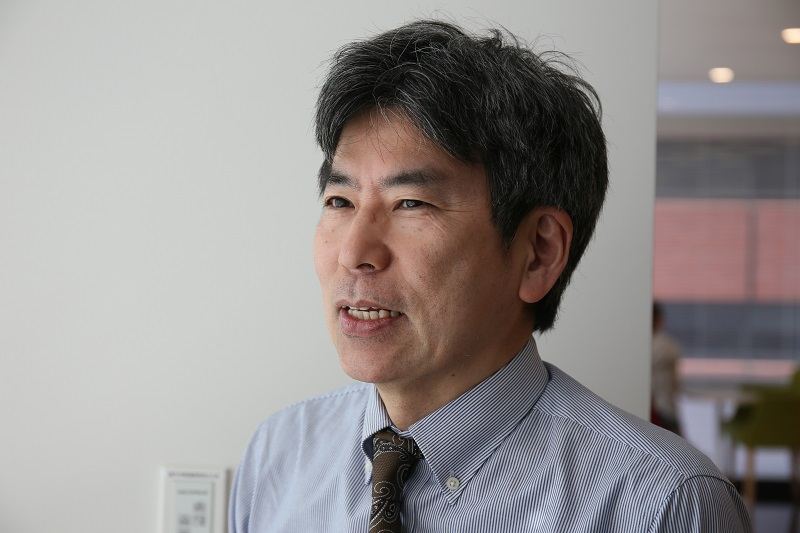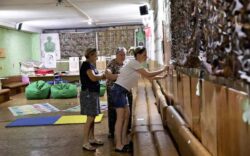Why not let students manage their own sports clubs at school?

Junior high school students enjoying basketball. Sports club activities in junior high schools will be the first to be transferred to local management.
8:00 JST, September 24, 2022
People often have nostalgic memories of their junior high and high school years. Working hard with your peers in the sport you choose may be one such memory. I was a member of the basketball team in high school, and I feel a strong sense of belonging to the club’s alumni association even now, long after I graduated.
Everyone who has been in a sports club may have a story to tell. However, the activity differs from person to person. Some may have spent their days training intensely under the guidance of coaches, with a dream of becoming a professional in the future. Others may have tried to balance studies and sports, or just hung out in the club room and enjoyed talking with their peers.
It also changes depending on when you experienced it. Now you can be absent from school for official games, but in the past, schools did not allow travel to other prefectures to compete in tournaments. It was not until the 1964 Tokyo Olympics that the clubs began to function as places for player development and discovery. In the 1980s, against a backdrop of “rough schools,” sports clubs attracted attention for their role in student guidance and student management.
Such club activities are to be taken out of the hands of the schools soon.
According to a policy proposal adopted in June of this year by the Sports Agency’s study council, schools are to withdraw from the management of sports club activities. The council, which consists of local governments, sports officials and school officials, proposed that the transfer will begin next year for public junior high schools on Saturdays and Sundays, and eventually all club activities, including those on weekdays, will be transferred.
The new clubs will be run by someone in the local community, such as private companies that operate local sports clubs or sports classes; volunteer organizations of local residents; or athletic organizations. It is not known what will happen to the activities as a result. What is certain is that club activities, which used to be school-based educational activities, will become community-based lifelong sports activities.
Prior to this policy proposal, several club-activity reforms had been implemented.
The changes were triggered by the suicide of a high school student who was the captain of the school’s basketball team in December 2012. Since excessive coaching was identified as the cause of the suicide, guidelines for coaching methods were first established in 2013. They clearly stated that corporal punishment was prohibited, and that words and actions that denigrate a person’s character were not tolerated. In 2018, comprehensive guidelines were established, which included a minimum requirement for two days of rest per week and a limit of two hours of practice time on weekdays and three hours on Saturdays and Sundays, among other measures to reduce the burden on students.
There are two reasons for the latest change. The first reason is that the number of children is decreasing and school-based club activities can no longer be maintained in some areas. The second reason is that teachers with no experience in sports are being asked to provide coaching, including on holidays, and this is placing a heavy burden on them.
At a meeting of the Central Council on Education held at the end of July, however, various concerns were raised. Tsutomu Togasaki, 67, the superintendent of education in Toda City, Saitama Prefecture, warned: “If schools become only a place for classes and events, the number of children who cannot be saved will increase and there will be more rough schools. A concrete vision of the future of junior high and high schools losing club activities should be drawn up.”
According to Togasaki, there was a growing momentum to make club activities more student-centered until quite recently. The idea was to have the students run the clubs on their own without being told what to do by teachers. “When the results of an OECD survey came out that showed the overwork of Japanese teachers, and that club activities were the cause, the whole story changed,” he said regretfully. It was clear that the reform of teachers’ work styles was given top priority, and the importance of students’ active participation seemed to be somehow forgotten.
“The nature of club activities from the viewpoint of the qualities and abilities required in the age of AI and robots has not been discussed enough,” he continued. “We should also consider the possibility that some students will lose the opportunity for self-realization.”
Sports club activities tend to keep growing endlessly. I used to be a volunteer coach for an elementary school basketball team. I coached two days a week, on Saturdays and Sundays. I really enjoyed coaching. It was more fun if we won the games, so I worked very hard with a belief that the kids also wanted to win.
The more I coached, the more the parents thanked me, and the hours of practice increased endlessly. The burden on the coaches, the parents and the children increased, and eventually, the school determined it was inappropriate and placed a limit on the number of activity days.
Prof. Atsushi Nakazawa of Waseda University, 42, an expert on sports club activities, says we can find some value in the transfer of club activities to local management. On the other hand, he agrees with the point that it is risky to think about the transfer only in terms of sports activities. “We should think more about the significance of what has been done in sports clubs as educational activities in schools,” he says.
In order to be more competitive in games, students are expected to think and act proactively. One expert describes coaching junior sports as “training horses.” He says that if students do not practice proactively, they cannot compete in the world. I once attended a coaches’ workshop of the Japan Basketball Association, and I learned that coaching is different from teaching.
Club activities have grown too big to control. It may have been unavoidable to take them out of the school system. What I am concerned about is that those activities will be taught by adults, with little space for students to experience freedom. It is not easy to secure a sufficient number of good coaches.
If that is the case, why not just go ahead and leave the majority of the management of the clubs to the students? This would foster a sense of responsibility and solidarity among the students, just as club activities at schools have done in the past. It would also allow them to experience a sense of accomplishment and improve their competitive skills.
Political Pulse appears every Saturday.

Makoto Hattori
Hattori is a staff writer in the Education News Department of The Yomiuri Shimbun.
"Editorial & Columns" POPULAR ARTICLE
JN ACCESS RANKING





